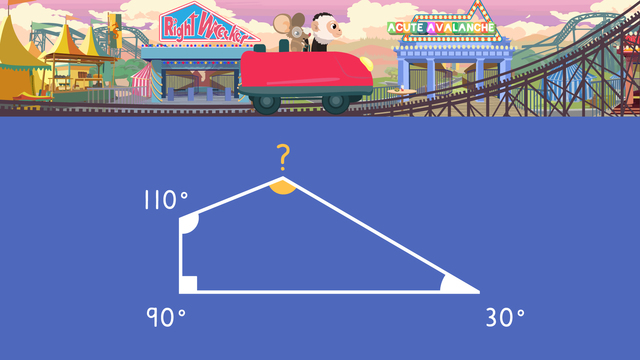Angles as Fractions of a Circle
- Exploring Angles in a Circle
- Introducing Angles as Fractional Parts of a Circle
- Angles as Fractional Parts of a Circle – Definition and Rules
- Angles as Fractional Parts of a Circle - Commonly Used Fractions
- Understanding Reflex Angles
- How to Find Angles in a Circle?
- Angles in a Circle – Summary
- Frequently Asked Questions about Angles in a Circle


Basics on the topic Angles as Fractions of a Circle
Exploring Angles in a Circle
Have you ever thought about the thrilling rides at amusement parks and wondered how they relate to maths? Join us on an imaginary Ferris wheel adventure, where we'll delve into the fascinating world of angles in a circle.
Introducing Angles as Fractional Parts of a Circle
Next time you find yourself on a Ferris wheel, consider how the concept of angles plays a role in this ride. Angles, circles and angles in a circle are everywhere, from the hands of a clock to the wheels of a car, and even in the thrilling rides at amusement parks.
Angles as Fractional Parts of a Circle – Definition and Rules
Let’s revise how angles occur first:
An angle is created when two rays meet at the same point at the center of a circle.
When an angle rotates or turns, a total of three hundred and sixty degrees, it forms a circle. We can divide a circle into fractional parts and measure the degrees of those angles.
Angles as Fractional Parts of a Circle - Commonly Used Fractions
Understanding angles can be made easier by looking at fractions of a circle. A quarter turn of a circle forms a right angle that measures ninety degrees, a half-circle measures one hundred and eighty degrees, and three-quarters equals two hundred and seventy degrees.
Here is the table with commonly used angles that are expressed as fractions of a circle:
| Fraction of a Circle | Parts in a Circle | Calculation | Angle size |
|---|---|---|---|
| $\frac{1}{2}$ | 2 | 360÷2 | 180 degrees |
| $\frac{1}{4}$ | 4 | 360÷4 | 90 degrees |
| $\frac{3}{4}$ | 4 | 360÷4 = 90, 90 x 3 = 270 | 270 degrees |
Understanding Reflex Angles
Did you know there's a special type of angle called a reflex angle? These angles are greater than one hundred and eighty degrees but less than three hundred and sixty. They are intriguing and can be found in various shapes and patterns.
How to Find Angles in a Circle?
Calculating the degree of a fractional part of a circle is a fun puzzle to solve. Take the total degrees of three hundred and sixty and divide it by the number of parts, then multiply by the shaded parts. For example, four-tenths of three hundred and sixty equals one hundred and forty-four degrees.
Take a look at the table for more examples of how to calculate angles that are fractional parts of a circle
| Fraction of a Circle | Parts in a Circle | Shaded Parts | Calculation | Angle size |
|---|---|---|---|---|
| $\frac{2}{6}$ | 6 | 2 | 360÷6= 60, 60 x 2 = 120 | 120 degrees |
| $\frac{5}{8}$ | 8 | 5 | 360÷8 = 45, 45 x 5 = 225 | 225 degrees |
| $\frac{4}{10}$ | 10 | 4 | 360÷10 = 36, 36 x 4 = 144 | 144 degrees |
Angles in a Circle – Summary
Angles and fractions aren't just in textbooks; they're part of everyday life. From the architectural marvels to the simple door hinge, you'll find angles everywhere. Try finding angles in circles and other circular objects around you and practise your newfound skills.
Following the video, there is additional practise with exercises and angles in a circle worksheet.
Angles as fractional parts of a circle is a fascinating concept that connects maths with the world around us. Whether it's a thrilling Ferris wheel ride or the hands of a clock, angles are everywhere. Dive into this adventure, explore, and have fun learning!
Frequently Asked Questions about Angles in a Circle
Transcript Angles as Fractions of a Circle
"Nico, what's going on?" "The ride has stopped! "What are we going to do?" "Don't worry, I have a plan to get us out of here!" As Nico and Nia begin their daring escape down from the Ferris Wheel, we can find out about, “Angles as fractions of a circle.” An angle is created when two rays meet at the same point at the centre of a circle. An angle can rotate clockwise or anti-clockwise. When an angle rotates, or turns, a total of three hundred and sixty degrees, it forms a circle. We can divide a circle into fractional parts and measure the degrees of those angles. First, let’s look at some commonly used fractions made by turns of a circle. This is one-quarter of a circle. Look at the angle created by this quarter turn. One quarter of a circle creates a right angle that measures ninety degrees. This is half a circle and the angle measures one hundred and eighty degrees. Three-quarters of a circle is equal to two hundred and seventy degrees. This is also known as a reflex angle. A reflex angle is any angle that is greater than one hundred and eighty degrees, but less than three hundred and sixty degrees. A full turn of the angle is a circle and measures three hundred and sixty degrees. We can find the degrees of any fraction of a circle by solving how many parts out of three hundred and sixty degrees it covers. Let’s use Nico and Nia’s daring escape from the Ferris wheel to measure fractions of a circle. Their climb down has covered fourth-tenths of the Ferris wheel. To find how many degrees this is, we are going to find four-tenths of three hundred and sixty degrees. To start with, we are going to take the three hundred and sixty degree angle turn and divide it by the total number of parts. The circle is in ten parts. Three hundred and sixty divided by ten equals thirty-six. This means each one- tenth fraction has the value of thirty-six degrees. Now, we multiply thirty six by how many parts are shaded. There are four shaded parts to show four tenths. Thirty-six times four equals one hundred and forty-four. Four-tenths of three hundred and sixty is equal to one hundred and forty-four degrees. That means Nico and Nia turned one hundred and forty-four degrees on the Ferris Wheel. “Woah, something is happening! Hang on!” The ferris wheel started moving anti-clockwise and travelled backwards five-twelfths of the circle. To solve how many degrees the wheel has moved, we are going to find five-twelfths of three hundred and sixty. First, what is three hundred and sixty divided by twelve? It is thirty. Each fraction has the value of thirty degrees. Now, multiply thirty by the numerator, five. What is thirty times five? One hundred and fifty. That means they went anti-clockwise one hundred and fifty degrees. "This machine has gone haywire!" What fraction of the circle are we finding?We are finding three-fifths of three hundred and sixty. What do we do first? We divide three hundred and sixty by five. What is three hundred and sixty divided by five? Seventy-two. What is the next step? Multiply seventy-two by the numerator. What is seventy-two times three? Two hundred and sixteen degrees. Remember, an angle is created when two rays meet at the same point at the centre of a circle. When an angle rotates, or turns, three hundred and sixty degrees, it forms a circle. We can divide a circle into fractional parts and measure the degrees of those angles. To solve how many degrees are in the fraction: first, divide three hundred and sixty by the denominator, or number of parts the circle is divided into. Then, take the quotient and multiply it with the numerator, or number of shaded parts.” Here we go again!”
Angles as Fractions of a Circle exercise
-
Facts about circles.
HintsA half circle measures 180°.
A circle can be divided into several parts.
Solution- A circle measures a total of 360°.
- An angle that measures greater than 180° but less than 360° is called a reflex angle.
- When an angle rotates 360° it forms a circle.
- A circle can be divided into fractional parts.
- Two rays meeting at the same point at the centre of a circle form an angle.
-
Match the angles with the fractions.
HintsHere the circle has been divided into four equal parts.
The total turn of an angle to form a circle is 360°.
$\frac{1}{4}$ of a circle creates a right angle that measures 90°.
Solution- 90° = $\frac{1}{4}$
- 180° = $\frac{1}{2}$
- 270° = $\frac{3}{4}$
- 360°= $\frac{4}{4}$ or 1
-
Which statements are true?
Hints$\frac{1}{4}$ of a circle measures 90°.
A circle can be divided into several fractional parts.
A full circle measures 360°.
There are four correct options.
Solution- False: A circle is formed when an angle rotates a total of 270°.
- True: An angle can rotate clockwise or anti-clockwise.
- False: A circle can only be divided into four fractional parts.
- True: Half a circle measures 180°.
- True: A reflex angle is greater than 180° but less than 360°.
- True: An angle is formed by two rays meeting at a centre point.
-
When should they exit the Ferris wheel?
HintsFirst divide the circle into ten parts to find how many degrees between each stop.
Next, find how many degrees would be in five parts.
Multiply 36 with the numerator or the total number of shaded parts.
Solution- They have to find $\frac{5}{10}$ of 360°.
- To start they divide 360 into 10 parts. Each part is 36°.
- Next they multiply 36 by 5, which equals 180°.
- So the angle at which they think they can safely exit is 180°.
-
How many degrees must an angle rotate to form a circle?
HintsAn angle can rotate clockwise or anticlockwise.
Half a circle measures 180°
A quarter of a circle measures 90°.
SolutionA circle measures 360°.
-
What is the angle measure of Nico's pizza?
HintsFirst divide 360 by 12. This will give you the degrees in one fractional part.
Look for the angle size of Nico's pizza which is $\frac{4}{12}$.
Multiply the measure of each angle with the numerator from Nico's fraction.
Solution- Nico's pizza measures 120°
- To find $\frac{4}{12}$ of 360, first divide 360 by 12 to get 30
- Next multiply 30 by 4 to get 120
 Do you want to learn faster and more easily?
Do you want to learn faster and more easily?
















